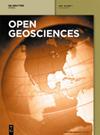MIF and AHP methods for delineation of groundwater potential zones using remote sensing and GIS techniques in Tirunelveli, Tenkasi District, India
IF 1.7
4区 地球科学
Q3 GEOSCIENCES, MULTIDISCIPLINARY
引用次数: 0
Abstract
The present study aims to identify whether the delineation of potential groundwater potential zones (GWPZs) is essential for monitoring surface and conserving underground water resources. This study analysed the morphology of earth surface characteristics such as geomorphology, lineament density, lithology, slope, soil types, land use and land cover, drainage density, land surface temperature, normalized difference vegetation index, rainfall, and topographic wetness index parameters to delineate the potential groundwater zones. This article applies the analytical hierarchy process (AHP) and multi-influence factor (MIF) methods to identify potential groundwater zones in the Tirunelveli and Tenkasi districts of Tamil Nadu, India. In the AHP method, individual parameter's geometric mean and normalized weights were determined using the pair-wise matrix analytical method. Remote sensing-geographic information system (RS-GIS) techniques were used to generate thematic map layers from normalized weights to delineate GWPZs. The GWPZs were classified as Very Low, Low, Medium, High, and Very High. The result shows that the GWPZs were identified as 3.57, 0.55, 6.62, 58.09, and 31.21% in the study area for the five classes, respectively. In this study, the thematic maps were also prepared by assigning fixed scores and weights from the MIF approach. In the MIF approach, GWPZs were classified into five classes and identified as 3.16, 0.33, 2.14, 61.21, and 33.16% in the study area, respectively. GWPZ maps were evaluated for both MIF and AHP techniques using the Kappa statistics method with agreement values of 0.77 and 0.72%, respectively. This study's GIS-RS method is more proficient and efficient in delineating the GWPZs.利用遥感和地理信息系统技术,采用 MIF 和 AHP 方法在印度 Tenkasi 地区的 Tirunelveli 划定地下水潜势区
本研究旨在确定潜在地下水潜势区(GWPZ)的划分对于监测地表和保护地下水资源是否至关重要。本研究分析了地表特征形态,如地貌、线状密度、岩性、坡度、土壤类型、土地利用和土地覆盖、排水密度、地表温度、归一化差异植被指数、降雨量和地形湿润指数参数,以划分潜在地下水区。本文采用层次分析法(AHP)和多影响因子法(MIF)确定印度泰米尔纳德邦 Tirunelveli 和 Tenkasi 地区的潜在地下水区。在 AHP 方法中,使用成对矩阵分析法确定了单个参数的几何平均数和归一化权重。利用遥感-地理信息系统(RS-GIS)技术,根据归一化权重生成专题地图图层,以划定全球水源保护区。GWPZ 被分为极低、低、中、高和极高。结果显示,在研究区域内,五个等级的 GWPZ 分别为 3.57%、0.55%、6.62%、58.09% 和 31.21%。本研究还采用 MIF 方法分配固定分数和权重,绘制了专题地图。在 MIF 方法中,GWPZ 被划分为五个等级,分别占研究区域的 3.16%、0.33%、2.14%、61.21% 和 33.16%。使用 Kappa 统计方法对 MIF 和 AHP 技术的 GWPZ 地图进行了评估,其一致性值分别为 0.77 和 0.72%。本研究的 GIS-RS 方法在划定 GWPZ 方面更加熟练和高效。
本文章由计算机程序翻译,如有差异,请以英文原文为准。
求助全文
约1分钟内获得全文
求助全文
来源期刊

Open Geosciences
GEOSCIENCES, MULTIDISCIPLINARY-
CiteScore
3.10
自引率
10.00%
发文量
63
审稿时长
15 weeks
期刊介绍:
Open Geosciences (formerly Central European Journal of Geosciences - CEJG) is an open access, peer-reviewed journal publishing original research results from all fields of Earth Sciences such as: Atmospheric Sciences, Geology, Geophysics, Geography, Oceanography and Hydrology, Glaciology, Speleology, Volcanology, Soil Science, Palaeoecology, Geotourism, Geoinformatics, Geostatistics.
 求助内容:
求助内容: 应助结果提醒方式:
应助结果提醒方式:


